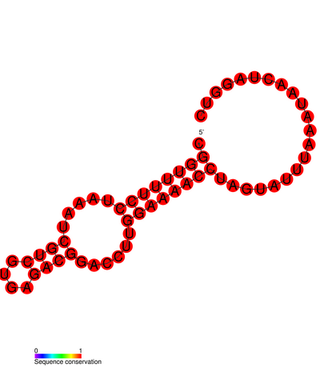
Geminiviridae is a family of plant viruses that encode their genetic information on a circular genome of single-stranded (ss) DNA. There are 520 species in this family, assigned to 14 genera. Diseases associated with this family include: bright yellow mosaic, yellow mosaic, yellow mottle, leaf curling, stunting, streaks, reduced yields. They have single-stranded circular DNA genomes encoding genes that diverge in both directions from a virion strand origin of replication. According to the Baltimore classification they are considered class II viruses. It is the largest known family of single stranded DNA viruses.

Nanoviridae is a family of viruses. Plants serve as natural hosts. There are currently 12 species in this family, divided among 2 genera and one unassigned species. Diseases associated with this family include: stunting. Their name is derived from the Greek word νᾶνος, because of their small genome and their stunting effect on infected plants.

Closteroviridae is a family of viruses. Plants serve as natural hosts. There are four genera and 59 species in this family, seven of which are unassigned to a genus. Diseases associated with this family include: yellowing and necrosis, particularly affecting the phloem.
Furovirus is a genus of viruses, in the family Virgaviridae. Graminae, winter wheat, wheat, triticale, oat, sorghum bicolor, and plants serve as natural hosts. There are six species in this genus. Diseases associated with this genus include: (SBWMV): green and yellow mosaic.

Phytoreovirus is a genus of viruses, in the family Reoviridae, in the subfamily Sedoreovirinae. They are non-turreted reoviruses that are major agricultural pathogens, particularly in Asia. Oryza sativa for RDV and RGDV, dicotyledonous for WTV, and leafhoppers serve as natural hosts. There are three species in this genus. Diseases associated with this genus include: WTV: galls (tumor). RDV: dwarf disease of rice. RGDV: dwarfing, stunting, and galls.
Pomovirus is a genus of viruses, in the family Virgaviridae. Plants and dicotyledons serve as natural hosts. There are five species in this genus. Diseases associated with this genus include: dwarfing of shoots (mop-top) and potato spraing disease. The name of the genus is derived from Potato mop-top virus, Potato mop-top virus, giving rise to Pomovirus.

Alphaflexiviridae is a family of viruses in the order Tymovirales. Plants and fungi serve as natural hosts. There are 65 species in this family, assigned to six genera. Diseases associated with this family include: mosaic and ringspot symptoms.
Babuvirus is a genus of viruses, in the family Nanoviridae. Musa species serve as natural hosts. There are three species in this genus. Diseases associated with this genus include: stunting, severe necrosis and early plant death. BBTV induces banana bunchy top disease (BBTD).
Capillovirus is a genus of viruses in the order Tymovirales, in the family Betaflexiviridae. Plants, pome fruits, citrus, and pear serve as natural hosts. There are four species in this genus. Diseases associated with this genus include: abnormal graft union, possibly black necrotic leaf spot disease.

Caulimovirus is a genus of viruses, in the family Caulimoviridae order Ortervirales. Plants serve as natural hosts. There are 12 species in this genus. Diseases associated with this genus include: vein-clearing or banding mosaic.
Cavemovirus is a genus of viruses, in the family Caulimoviridae order Ortervirales. Plants serve as natural hosts. There are three species in this genus. Diseases associated with this genus include: vein-clearing or banding mosaic.
Enamovirus is a genus of viruses, in the family Solemoviridae. Plants serve as natural hosts. There are five species in this genus. Diseases associated with this genus include: pea enation disease: if both PEMV-1 and PEMV-2 are present.
Marafivirus is a genus of viruses in the order Tymovirales, in the family Tymoviridae. Plants serve as natural hosts. There are 11 species in this genus.

Nanovirus is a genus of viruses, in the family Nanoviridae. Legume plants serve as natural hosts. There are 11 species in this genus. Diseases associated with this genus include: stunting, severe necrosis and early plant death.
Soymovirus is a genus of viruses, in the family Caulimoviridae order Ortervirales. Plants serve as natural hosts. There are four species in this genus.
Topocuvirus is a genus of viruses, in the family Geminiviridae. Dicotyledonous plants serve as natural hosts. There is only one species in this genus: Tomato pseudo-curly top virus. Diseases associated with this genus include: vein swelling, curling of the leaves and leaf distortion.
Becurtovirus is a genus of viruses, in the family Geminiviridae. Dicotyledonous plants serve as natural hosts. There are three species in this genus.
Eragrovirus is a genus of viruses, in the family Geminiviridae. Dicotyledonous plants serve as natural hosts. There is only one species in this genus: Eragrostis curvula streak virus.
Solendovirus is a genus of viruses, in the family Caulimoviridae order Ortervirales. Plants serve as natural hosts. There are two species in this genus. Diseases associated with this genus include: TVCV: vein-clearing symptoms in N. edwardsonii.
Turncurtovirus is a genus of viruses, in the family Geminiviridae. Dicotyledonous plants serve as natural hosts. There are three species in this genus.





